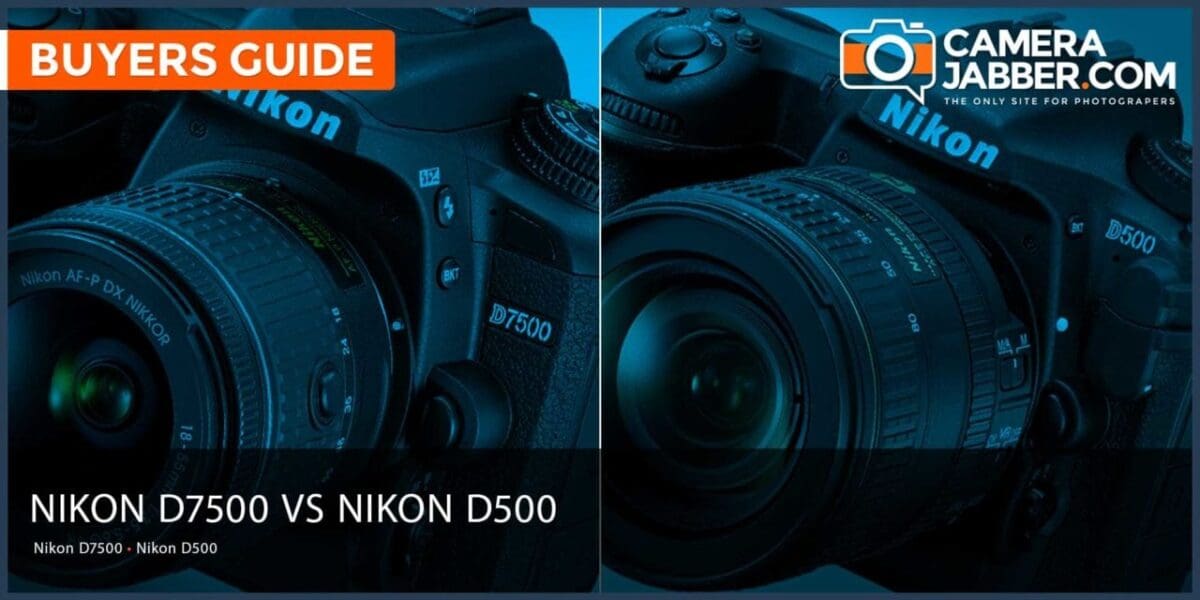Nikon has introduced the D7500 as a smaller, more affordable alternative to the professional-level D500. In this Nikon D7500 vs D500 comparison we examine the key specifications and identify the main differences.
Nikon D7500 Specifications
- Sensor size: APS-C (23.5 x 15.7mm)
- Effective pixel count: 20.9 million (5568 x 3712)
- Processor: Expeed 5
- Lens/Mount: F
- Viewfinder: Optical with pentaprism 100% coverage
- Sensitivity range: ISO 100-51,200 expandable to ISO 50-1,640,000
- AF System: 51-point with 15 cross-type
- Monitor: 3.2-inch TFT LCD with 922,000 dots
- Max shooting rate: 8fps
- Max video resolution: 4K (3840 x 2160)
- Storage: SD/SDHC/SDXC (UHS-I)
- Dimensions: 135.5 x 104 x 72.5 mm/5.4 x 4.1 x 2.9 in
- Weight: 640g body only, 720g with battery and card
Nikon D500 Specifications
- Sensor size: APS-C (23.5 x 15.7mm)
- Effective pixel count: 20.9 million (5568 x 3712)
- Processor: Expeed 5
- Lens/Mount: F
- Viewfinder: Optical with pentaprism 100% coverage
- Sensitivity range: ISO 100-102,400 expandable to ISO 50-1,640,000
- AF System: 153-point with 99 cross-type
- Monitor: 3.2-inch TFT LCD with 2,359,000 dots
- Max shooting rate: 10fps
- Max video resolution: 4K (3840 x 2160)
- Storage: XQD and SD/SDHC/SDXC (UHS-II)
- Dimensions: 147 x 115 x 81 mm/5.8 x 4.6 x 3.2 in
- Weight: 860g with battery and XQD card
Sensor and processing engine
Nikon has given the D7500 the same 20.9Mp DX or APS-C format sensor as the D500. The chip is also paired with the same Expeed 5 processing engine and it should mean that the new camera is able to produce the same quality images as the pro-level D500.
Continuous shooting
Although they have the same sensor and processing engine, the D7500 can’t match the 10fps (frames per second) maximum continuous shooting rate of the D500. Nevertheless, the D7500 can still muster 8fps, which will satisfy many experienced photographers.
Autofocus system
While the D7500 has a 51-point (15-cross-type) AF system, the D500 has a system with 153 points and 99 of them are cross type. This means that the D500 is going to be that bit better at picking up a small subject and tracking it across the image frame.
Touch-control
Both cameras have a 3.2-inch tilting touch-screen but the D500’s touch-control is much more limited than the D7500’s. It’s primarily used for setting AF point in live view mode or swiping through images and zooming in and out in review mode. It’s not possible to make menu selections or settings adjustments using the D500’s screen, but you can with the D7500.
Screen
It’s also worth noting at this point that although the cameras have the same size screen, the D7500’s has 922,000 dots while the D500’s has 2,359,000. In the past 922,000-dots screens have proved themselves perfectly acceptable, but a higher resolution model is just that bit crisper.
Control layout
Nikon has blended the D500’s and D7200’s control arrangements for the D7500. On the top-plate for example where the D500 has four buttons to access the image quality, white balance, metering and exposure mode options, the D7500 has a mode dial. The D7500’s image quality, white balance and metering buttons are found on its rear, to the left of the screen.
The D7500 also lacks the D500’s mini joystick controller that falls conveniently under your thumb for setting AF point. This isn’t a major drama as the navigation pad allows the point to be set quickly enough.
Memory card ports
While the D500 has dual card ports, one to accept XQD and the other SD/SDHC/SDXC, the D7500 only has one SD/SDHC/SDXC port. Also, the D7500’s port is UHS-I compliant whereas the D500’s SD port is UHS-II compliant.
Size and weight
At 135.5 x 104 x 72.5 mm (5.4 x 4.1 x 2.9 in), the D7500 is smaller in every dimension than the D500 147 x 115 x 81 mm/5.8 x 4.6 x 3.2 in. However, with a battery and card installed (XQD in the case of the D500), there’s only 20g difference in weight. That’s a little less than an ounce and it’s unlikely to be noticeable when the camera is in use or in your bag.
Should I buy the Nikon D7500 or D500?
Let’s be clear: both are fantastic cameras. The difference here really comes down to how seriously you take your sport or action photography. If you’re a professional photographer, or a serious enthusiast hoping to break into paid work, it’s probably worth investing in the Nikon D500.
The Nikon D500’s 10fps burst mode and 153 AF points gives you a lot more flexibility it fast-moving situations. And if your paycheck depends on getting these shots, well, the D500 won’t let you down.
That said, for everyone else – those who might want to photograph their child’s football game, surfers at the beach, etc – and share those images online, with perhaps the odd print, the Nikon D7500 will be more than adequate.



